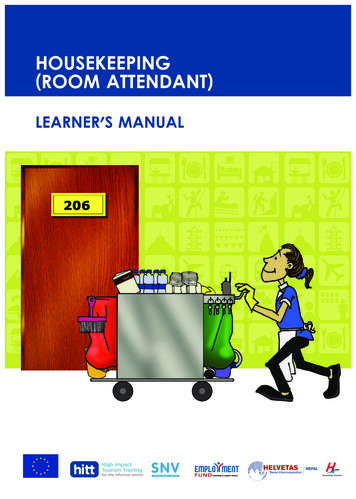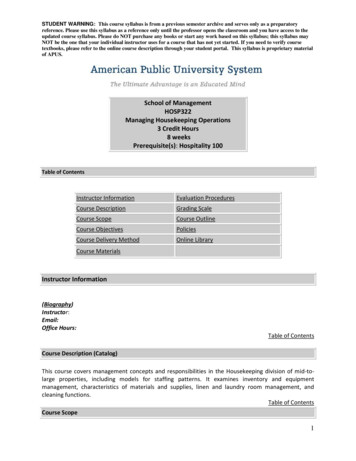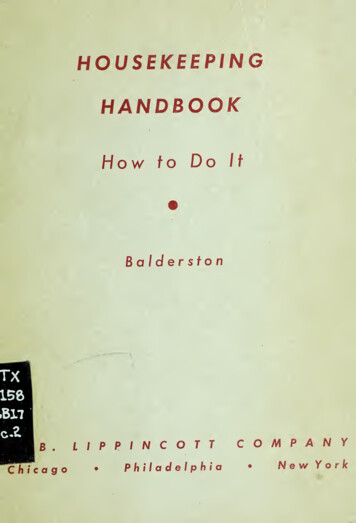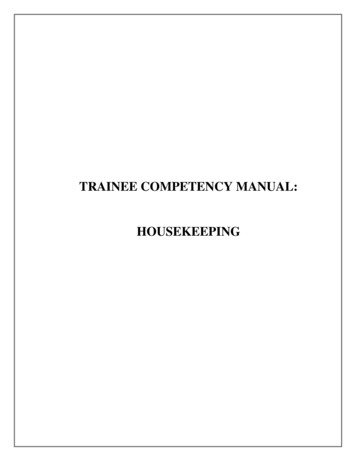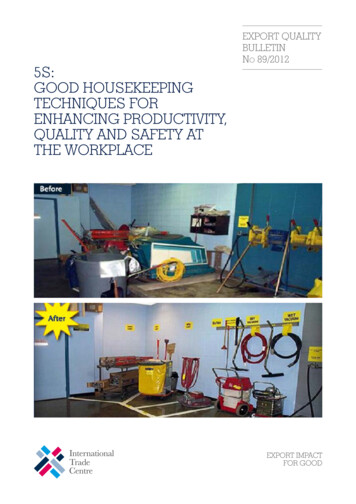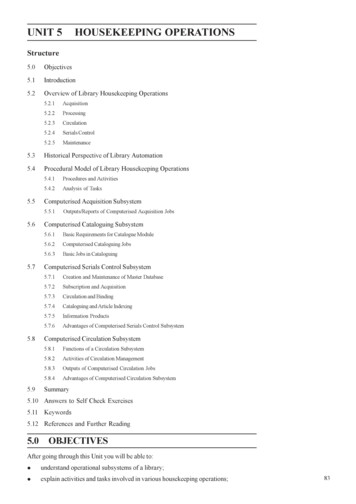
Transcription
UNIT 5HOUSEKEEPING Overview of Library Housekeeping ulation5.2.4Serials Control5.2.5Maintenance5.3Historical Perspective of Library Automation5.4Procedural Model of Library Housekeeping Operations5.55.4.1Procedures and Activities5.4.2Analysis of TasksComputerised Acquisition Subsystem5.5.15.65.75.85.9Outputs/Reports of Computerised Acquisition JobsComputerised Cataloguing Subsystem5.6.1Basic Requirements for Catalogue Module5.6.2Computerised Cataloguing Jobs5.6.3Basic Jobs in CataloguingComputerised Serials Control Subsystem5.7.1Creation and Maintenance of Master Database5.7.2Subscription and Acquisition5.7.3Circulation and Binding5.7.4Cataloguing and Article Indexing5.7.5Information Products5.7.6Advantages of Computerised Serials Control SubsystemComputerised Circulation Subsystem5.8.1Functions of a Circulation Subsystem5.8.2Activities of Circulation Management5.8.3Outputs of Computerised Circulation Jobs5.8.4Advantages of Computerised Circulation SubsystemSummary5.10 Answers to Self Check Exercises5.11 Keywords5.12 References and Further Reading5.0 OBJECTIVESAfter going through this Unit you will be able to: understand operational subsystems of a library; explain activities and tasks involved in various housekeeping operations;83
Library Automation streamline library housekeeping operations for more efficient functioning; make yourself aware about the application of ICT in housekeeping operations; and perform automated housekeeping jobs related to acquisition, cataloguing, serialscontrol and circulation.5.1 INTRODUCTIONA library of any type or size implies the close collaboration of the trio, i.e., the documents,the users and the library personnel. Library personnel are the matchmakers between theuser and his or her document of interest. The services provided by library staff comprisea series of jobs namely, acquiring, preparing and preserving the documents. The activitiesrelated to acquisition of documents and making them available to the users, technicalprocessing of acquired documents; circulation and maintenance of processed documentsare known as housekeeping operations. These activities are highly labour-intensive andbasically routine clerical chores performed slowly and expensively by human beings,until recently. With the advent of Information and Communication Technologies (ICT),libraries are increasingly attempting to automate some of these activities for minimisinghuman clerical routines and thereby making library staff more productive and enablingthem to provide fast and comprehensive information through services.5.2OVERVIEW OF LIBRARY HOUSEKEEPINGOPERATIONSThe performance of a library largely depends on the organisation of its housekeepingoperations. Most of the activities related to library housekeeping follow some definiteroutines and obviously amenable to computerisation. It means a computer or a group ofcomputers can perform routine clerical chores quickly and cheaply. The basic functionsrelated to housekeeping operations in a library irrespective of type or size may be groupedas RecallInter LibraryLoan (ILL)PhotocopyBindReplaceDiscardFig. 5.1: Divisions of Library Housekeeping Operations84The activities of these functional groups are entirely different from other divisions butthey are closely connected in a sequence and the combined efforts lead to better libraryservices. It can be seen that libraries are complex systems that include subsystems andcomponents. The main two subsystems are the operational subsystem and theadministrative subsystem. Library housekeeping operations are part of the operationalsubsystem. According to an analytical study of ASLIB (Association for InformationManagement, UK), the operational subsystem may be divided into four further subdivisions,
namely, Acquisition, Processing, Use and Maintenance. Within each of these divisionsthere are a number of procedures and within each procedure there are one or more of sixpossible activities. Such subsystems procedures and activities related is monogroups in aLibrary are listed the Table-5.1.HousekeepingOperationsTable 5.1: Procedures and Activities of Library rveRecall/ReturnILL (Inter Library Loan)PhotocopyBindReplaceDiscardActivities(Common to allProcedures)Initiate(To commence a procedure)Authorize(To approve a procedure)Activate(To implement a procedurethrough appropriateaction)Record(To record what action hasbeen taken)Report(To notify staff or userabout the action taken)Cancel(To stop a procedure orundoing an isition of documents is a basic function of libraries. A library should acquire andprovide all the relevant documents to its users so that the basic functions of the library arefulfilled. An acquisition subsystem shall perform four basic procedures – Select, Order,Receive and Accession. These procedures are explained below:a)Select: Selection of documents for a library is a very responsible job and should bebased on definite principles. It is done with the help of selection tools (such asbibliographies, publishers’ catalogues, book references, etc.) and requests/suggestionsfrom library users received. Purchase orders are sent after formal sanction of thecompetent authority/library is obtained.b)Order: Before placing purchase orders with the suppliers each title to be ordered ischecked with the catalogue and supply orders sent earlier to avoid duplication inordering them. In the next stage purchase orders are generated and placed eitherdirectly to the respective publishers or to the approved vendors/book sellers.Additionally, generation of reminders for overdue supplies and cancellation of ordersis also done as necessary.c)Receive: When the documents ordered are received the bills covering the suppliesare checked with the purchase order list before processing for payment. Care is tobe taken to ensure the details (the author, title, edition; imprints etc.) of the bookssupplied are the same as per the purchase order.d)Accession: A stock register is maintained by libraries in which all the documentspurchased or received in exchange or as gift are entered. Each document is provided85
Library Automationwith a consecutive serial number. The register is called Accession Register and theserial number of the document is referred as Accession Number.All these procedures and related activities of the acquisition subsystem can be mechanisedthrough suitable library management software. In such a library automation system thesebasic activities are linked with the files of publishers, suppliers, budget and fund accounting,currency etc. to achieve the benefit of an integrated library system.5.2.2ProcessingThe processing procedure is the pivot around which all the housekeeping operations revolvein a library. It helps in the transformation of a library collection into serviceable resources.The procedures under this subdivision are classification, cataloguing, labelling and shelving.a)Classify: Classification is grouping of similar objects together. It forms the foundationof librarianship. The following are the important classification schemes, which areused in various libraries across the world - Dewey Decimal Classification Scheme(DDC), Universal Decimal Classification Scheme (UDC), Library of CongressClassification (LC), Colon Classification (CC) and Subject Classification (SC) etc.There are two purposes for classification of documents: To help the user to find a document whose call number he/she knows To find out all the documents on a given subject though collocationClassification of documents involves analysis of the subject content and representationof the content by class numbers. Thus, it is an intellectual process. So, to automatethe classification work, suitable artificial intelligence (AI) techniques are to be used.In India, some research work has been carried out at DRTC, Bangalore for buildingclass numbers (based on Colon Classification) automatically through a software(called Vasya), written in PROLOG (PROgraming in LOGic) – a non-proceduralprogramming language. The present edition of DDC is also available in CDROMand known as Electronic Dewey.b)Catalogue: A basic task in a library is to prepare a catalogue of its collection andmaintain it upto date for meeting the information needs of its users. Cataloguing isthe prime method of providing access to the collection. The current practices ofcataloguing of resources in Indian libraries are listed in Table 5.2:Table 5.2: Catalogue ProductsGroupProductCataloguing Procedure1.Manual cataloguing Card catalogue2.Computerised cataloguing Machine readable catalogueOPAC (Online Public AccessCatalogue) 3.86Hybrid Model(Use of computer to producecatalogue on cards and manualfiling and also catalogue inmachine – readable form) Printed catalogue cardMachine readable catalogueOPAC (Online Public AccessCatalogue)In case of manual cataloguing, the cataloguer makes separate cards for author, title,subject, cross-references and analytical entries by following any standard catalogue code(such as AACR II, CCC, etc.) and file them as per the rules laid down by the library.Computerised cataloguing begins with entering bibliographical data in a pre-designedworksheet. The worksheet or datasheet is very similar to data entry form and is based onany standard content designators scheme (such as MARC 21, CCF, UNIMARC, etc.).Finally bibliographical data recorded in the worksheets are entered into the computer to
produce machine-readable catalogue file and OPAC. Computer-based cataloguing supportsimporting of bibliographical datasets for the library resources either from centralisedcataloguing services or from other libraries and exporting of bibliographical data from itsown collection to other library systems. This facility reduces unit cost of cataloguing andensures standardisation in cataloguing. The recent trend of cataloguing is to utilize Z39.50protocol to download bibliographical data from other libraries and to provide global accessto its own collection through Web-OPAC.c)HousekeepingOperationsLabel: Labelling involves pasting various labels on different parts of a document.The following labels are generally pasted in books:lSpine label: This is done to make call number (a combination of class numberand book number) properly visible to the users when the book is shelved. Thesize of the label is in the range of 1.25" 1.25".lOwnership slip/mark: These are generally pasted on the inner side of the frontcover at left hand top most corner. Ownership marks are also put at variousparts of a document by rubber stamps. The size of slip/markis 3" 2.5".lDate slip: It is pasted on the top most portion of the front or back flyleaf ofeach book. The size of date slip is 5" 3".lBook pocket: On the bottom of the inner right side of the front cover or backcardboard cover a book pocket is pasted.lBook card: One printed/hand-written book card of size 5" 3" is put in thebook pocket of each book.In a computerised environment, various labels are printed by using library managementsoftware. In case of barcode-based computerised circulation, accession numbers ofdocuments are converted into barcodes and printouts of barcodes are pasted on the innerback cover of documents.d)Shelve: Shelving is the arrangement of documents on the shelves to fulfill the fourthlaw of library science – ‘Save time of the reader’. Generally, books are arranged onthe shelves in a classified order as per the call number. Bound periodicals are generallyshelved alphabetically by title and then by volume numbers.5.2.3CirculationMost libraries lend books and other library materials to be read elsewhere by users.This function requires some sort of record keeping arrangement of what has been lentand to whom.A rich variety of systems of record keeping of loans have arisen out of such needs andthese are known as circulation systems. These include some common jobs for successfuloperations such as enrolment of members, issue and return of library documents, reservationof documents, renewal of documents, maintenance of documents and records, maintenanceof statistics, interlibrary loan, issuing of gate pass, etc. In a computer-based circulationsystem, the machine-readable file consists of records for all items on loan from the libraryand it is updated periodically with new records. This file is called “transaction file” and ittakes required data from other two files – “document file” and “borrower file”. Modernlibrary management softwares support barcode-based circulation system. In such a systema barcode reader scans bar-coded accession number of a document and the barcode inturn acts as a pointer to the document file. It helps to minimise labour and error in dataentry operation. The concept of RFID (Radio Frequency IDentification) based circulationsystem is emerging rapidly in developed countries. It comprises three components: a tag,a reader and an antenna. The tag contains important bibliographical data. The readerdecodes the information stored on the chip after receiving it through the antenna andsends data to the central server to communicate to the library automation system. RFID87
Library Automationtechnology supports user self-checkout machines and has the ability to conduct inventorycounts without removing a single book from shelves. As a whole, RFID improves libraryworkflow, staff productivity and customer service with these attributes.5.2.4 Serials ControlSerials in general and periodicals in particular are essential for research and development(R & D) activities. These are the primary means of communication for the exchange ofinformation and ideas. The periodicals or journals subscribed by libraries can be groupedinto these categories: Indexing/Abstracting periodicals Periodicals containing news items Periodicals containing full-text research articles and technical papers.Acquisition of serials/periodicals in a library is different from book ordering system. Incontrast to books, the libraries regularly subscribe to periodicals against advance payment.The modes of subscription of periodicals in a library are as follows: Through local vendors/subscription agents Through foreign vendors/subscription agents Direct from the publishers As gift or Complementary Through membership In exchange.The fundamental tasks of any serials control system manual or mechanised can be listedas below:1)Selection of serials2)Selection of subscription mode3)Formulation of terms of procurement4)Selection of vendors5)Placing supply orders6)Making advance payment7)Receiving and registration of serials issues in a kardex system.8)Sending reminders for issues not received.9)Making adjustments in advance payments for missing issues10) Preparation of lists of subscribed journals, new arrivals and serials holdings forconsultation by users8811) Binding and accessioning of back volumes of serials In an automated system allthese tasks are performed by library management software efficiently. It reducesworkload of library staff. Computer based serials control systems may be predictiveor non-predictive. Predictive systems predict the arrival of individual journal issuesand can generate reminders for of non-receipts of issues. Prediction means theability to inform that a particular issue of a particular journal will arrive in the librarywithin a stated time interval. Modern library management software supportspredictive mode of serials control with the facilities of online acquisition and accessof journals through World Wide Web (WWW).
5.2.5 MaintenanceHousekeepingOperationsIf we don’t take proper care to organise and administer the library documents regularly,these documents would become unserviceable resources soon. The workflow of themaintenance division/section includes following tasks: Shelf Rectification:Shelving misplaced documents in proper locations Bind:Preserving library resources for posterior and present use Replace:Replacing a lost document by the library Discard/Withdrawn :Weeding out out-dated, torn and unserviceable documentsfrom the library.The integrated library automation environment requires information on lost, damaged,missing and withdrawn documents as well as documents sent for binding. These datasetsare to be entered to generate and display appropriate messages for the library users andstaff. This is also required to generate reports on lost books, missing books, books sent forbinding, and so on, for the library administration.5.3HISTORICAL PERSPECTIVE OF LIBRARYAUTOMATIONThe whole automation process in our society began with a librarian – Dr. John ShawBilling. Herman Hollerith, a Census Bureau of USA employee, who invented punchedcard machinery, attributes the idea to a suggestion by Dr. Billing, the then librarian ofSurgeon-General’s Library (now the National Library of Medicine). Hollerith formed theTabulating Machine Company in 1896, which later became the International BusinessMachines (IBM) Corporation. Libraries are an important component of the modern socialapparatus for the management of public knowledge. The existing library practices andprocedures began to break down under economic, social and bibliographical pressureemerging in the late 1950s and early 1960s. Librarians then began seeking relief inautomation. Rapid developments in computer and communication technologies have beencatalysing the development of automated library systems. A decade wise analysis ofdevelopments related to library automation reveals following facts: First there was the pre computer era of unit record equipment Then came the offline computerisation in the 1960s and the early 1970s This was followed by the online systems of the 1970s. The 1980s saw the advent of microcomputers and the emergence of CD-ROMtechnology. Finally, we came to the Internet revolution of the 1990s.The effects of ICT on libraries and information centers are characterised by: Mechanisation – doing what we were already doing, but more efficiently Innovation – experimenting with new capabilities, that the ICT makes possible Transformation – fundamentally altering the nature of the library operations andservices through the capabilities extended by ICT1936-60: These developments can be furthed detailed as follows:Punched card forcirculation control; Use of IBM 402, 403 or 407, sorting and retrieval of data;Introduction of the concept of ‘Memex’ by Vannevar Bush in 1945.1960-70: Use of general-purpose computers that became widely available in the 1960s;H.P. Luhn, in 1961, used a computer to produce the “Keyword in Context” orKWIC index for articles appearing in Chemical Abstracts; Project “MEDLARS”started in 1961. Computerised circulation system first appeared in 1962. Project‘Intrex’ which, it was hoped, would provide a design for evolution of a largeuniversity library as a new information transfer system, started in 1965. Project89
Library AutomationMARC, initiative by Library of Congress to provide a format for machinereadable cataloguing data, started in 1965; Introduction of on-line interactivecomputer system in place of offline batch processing systems began in mid1960s; Initiation of projects like BALLOTS by Stanford University and MACby M.I.T. These developments subsequently led to the automation of most ofthe library operations and services.1970-80: Minicomputers were introduced to automate circulation and books were barcoded; Computer based ordering systems were introduced to pass orders tobook and serial jobbers. ISBDs started appearing from 1971; OCLC wasestablished in 1971 to facilitate library cooperation and to reduce costs ofprocessing work. ISO-2709 was developed in 1973 as the standard for dataexchange format. OCLC started development of Worldcat in 1975 (Worldcatnow contains 46 million cataloguing records). Library networks begin appearingall over the world.1980-90: Shared copy-cataloguing systems by using computer and communicationtechnologies were established as a norm in 1980s. Remote access to onlinedatabases became a reality. Appearance of CD--ROM databases on indexingand abstracting journals started in early 1980s; Library automation packagesinitiated shifting towards relational architecture. Integrated automation packagesbegan appearing in mid 1980s along with bar-coded circulation system. OPACbecame very popular in this decade and made available on campus wide LANsfor accessing.1990:5.4Library automation packages started upgrading from client server architectureto web architecture. Large scale developments took place in the areas ofresource sharing, union catalogues and computerised inter-library loans. Releaseof Z39.50 protocol in 1995 to share bibliographical information and to overcomethe problems of database searching with many search languages; Formation ofcollective purchasing consortia that can negotiate prices for all members of theconsortium. Emergence of multimedia databases; Emergence of www andweb-based library services. Release of Dublin Core Metadata Standard in1995; Web-OPACs began appearing in almost all automated libraries.Conversion and digitisation of print contents into electronic format started in abig way; Full text access to information resources over Internet started againstIP authentication. Integrated access interface emerged to act as one-stop accessinterface; IFLA introduced FRBR as a conceptual data model for bibliographicaldatabases in 1999. Eprint archives and digital libraries. RFID are beingdeveloped in a big way. Smart card based user access to online library serviceshave come into use.PROCEDURAL MODEL OF LIBRARY HOUSEKEEPING OPERATIONSFor planning and designing automation of the operations of a library, it is necessary toanalyse them in necessary detail. A close analysis of those operations provides us threehierarchical levels – procedures, activities and tasks.5.4.1 Procedures and ActivitiesThe eighteen procedures listed in Table 5.2 are common to libraries of different types.The procedures under each and every operational subsystem have been analysed byP.A. Thomas in terms of six possible activities – initiate, authorise, activate, record, reportand cancel. All of these activities may not be involved in every procedure. There are oneor more six possible activities against each procedure. The six common activities aredefined as:90 Initiate – That which makes it apparent that a procedure should be commenced. Authorise – In some cases, the decision to carry out a certain procedure must beapproved before any further action is taken.
Activate – When a procedure is known to be necessary and in some cases approved,it is usually implemented by taking appropriate actions. Record – The function that states or records what action has been taken. Report – To notify library staff or user that an action has been taken. Cancel – To stop a procedure, in particular the aspect of revoking or undoingan action.HousekeepingOperations5.4.2 Analysis of TasksThe third level in the hierarchy is concerned with tasks within an activity under eachprocedure. Task means a related group of operations carried out to perform a particularkind of job. The analysis of tasks to perform activities within procedures may be donethrough a set of five primary questions: What information is needed for the activity? Where is the information to be obtained? When is it required? Who requires it? How is it used?These five questions should be asked to carry out possible activitiesunder each procedure. It provides depth to the framework provided by the proceduralmodel. An example of this approach is shown in Table 4 in the context of fivepossible activities of book order procedure in acquisition subsystem. Sharing and transferring data between different systems and media Availability of Distributed Information System (Internet) Increased capacity of data storage and data transmission Decreased cost and size of equipment Increased reliability of hardware and software to perform repetitive jobs Introduction of GUI based user friendly software with online help.Table 5.3: Analysis of Activities for Book OrderingSYSTEMSUBSYSTEMPROCEDURELIBRARY SYSTEMACQUISITION SUBSYSTEMORDERAUTHORIZEAuthor,Title,WhatSignature ofinformation? Sub-title, Edition, ApprovalPlace, Publishers,Date, ISBN etcACTIVATELibrary/Bran-chAdministrativeLibrary, Date ofdata, BibliograOrder, Order number, phic dataName of Vendor andBibliographi-caldetails etc.Order Number,and DateVendor, BookdetailsWhere from? entAuthorityBook SelectionTools, MISOrder File/ComputerDatabaseBeforeActivationAfter Authorisation AfterActivationACTIVITIESINITIATEWhen?After SelectProcedureWho?Library Asst./Technical Asst.How?Librarian/ Section- Library Asst./Technical AsstIn-ChargeReceiving copyEnter Signature Enter data/of Bibliographies,information on OrderSuggestion slipform/ ComputerDatabase andGenerate OrderRECORDOrder form/Order letterCANCELAfter ActivationLibrary Asst./Library clerkLibrary Asst.Filing the Copyof Order form/Saving inComputerDeletion fromDatabase/Removal fromFile91
Library AutomationSelf Check Exercise1)Explain procedural model of library automation.Note: i)ii)Write your answer in the space given below.Check your answer with the answers given at the end of the Unit.5.5 COMPUTERISED ACQUISITION SUBSYSTEMThe basic activities of any computerised ordering or acquisition subsystem can be specifiedas follows:lTo receive indents/suggestions for the documents to be acquiredlTo check whether items requested are already in the library or on orderlTo obtain approval of the competent authorities for purchase of the indented/suggesteddocumentslTo print orders or dispatch order electronically to supplier/publisherslTo check when orders are overduelTo follow up overdue orderslTo maintain a file of records of items on orderlTo note the arrival of ordered itemslTo process bills for paymentlTo maintain book fund statistics and accountslTo generate printed and electronic listing of various reportslTo control currency conversionslTo maintain vendor performance reports and statisticsThe acquisition module of modern Library Management Software(LMS) should also carryout the following jobs.92lAccommodate a variety of materials, including but not limited to – monographs,monograph series, annual and cumulative indexes, loose leaf materials, supplements,reports, musical scores,etc.lAccommodate and identify items in a variety of formats, including but not limitedto – print, microform, film, videotape, audio cassette, CD--ROM, magnetic tape, etc.lRecord, store and display - bibliographic information, acquisition type (order, gift,approval etc.), status (reported, received, etc.), library/branch/copy/fund information,invoice information, vendor information, accounting information, requestor informationetc.lAccommodate different types of orders – regular order, membership, approval,standing (continuing) order, deposit account etc.
5.5.1 Outputs/Reports of Computerised Acquisition JobsHousekeepingOperationsThe outputs form a computerised acquisition subsystem usually include the following:lLists/Reports of titles requestedlList/Report of item(s) from suppliers/publisherslItem(s) selected for approvallItem(s) approved by the authority/library committeelItem(s) rejected in the approval processlList of gratis item(s) received by librarylReport on request statuslPrintout of notes for obtaining approval of the competent authority forscreened titles.lPrintout or softcopy of order letters & query letterslPrintout or softcopy of reminder letterslPrintout or softcopy of order cancellation letterslPrintout or softcopy of reordering letterslLetters/notes for adjustment of advance paymentslLetters/notes to bank for foreign exchange ratelReports on order statuslList/reports of overdue supplying of titleslList/Reports of overdue itemslLists/reports of titles actually orderedlReports of budget commitmentlLists/Reports of item ordered against advance paymentlList/Reports of titles received against orderslLetters of intimation (on arrival of documents)lPrintouts of accession register entrieslPrintouts of barcode labelslList of supplier/publisherslList of currency and exchange rateslBudget with commitmentslReport of detailed annual budget of librarylReport on amount received in different budget headslReport/statistics of vendor performancelList of recent additionslGeneration of book cards (in case of integrated ordering and cataloguing system)93
Library AutomationSelf Check Exercise2)Write down the operations in computerised acquisition subsystem.Note: i)ii)Write your answer in the space given below.Check your answer with the answers given at the end of the Unit.
Dec 05, 2017 · UNIT 5 HOUSEKEEPING OPERATIONS Structure 5.0 Objectives 5.1 Introduction 5.2 Overview of Library Housekeeping Operations 5.2.1 Acquisition 5.2.2 Processing . Most libraries lend books and other library materials to be read elsewhere by users. This function requires some
